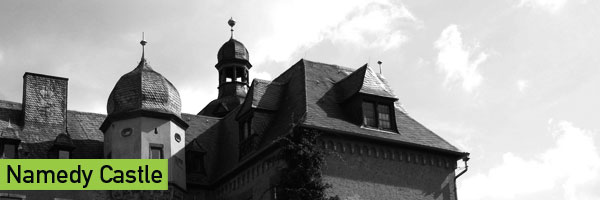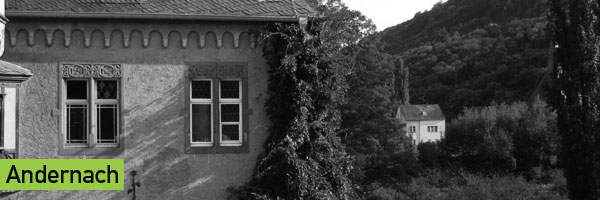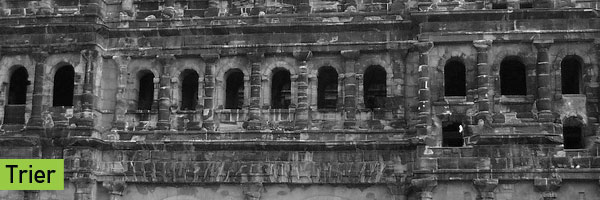
The city of Namedy has round about 1,300 inhabitants and is situated on the left bank of the Upper Middle Rhine Valley. Since 2002 Namedy is one of the UNESCO world heritage sites.
Nowadays Namedy is part of the city of Andernach and one of the oldest cities of Germany. The most important stages in the history of Namedy:
- Parts of Celtic settlements were found in Namedy.
- The abbey "Zisterzienserinnen-Kloster" was founded in 1255.
- There is a still existing underground connection between the old abbey and the Namedy Castle.
- In the 14th century the aristocratic Niederhof was built, which later on became part of the Namedy Castle.
- From 1801 on the French restored the devastated "Römerstrasse".
- From 1815 on Prussia had power over the left side of the Rhine.
Soon the Upper Rhine Valley became important for transit purposes because of the steamer traffic and newly built streets and railroads in this area. Viniculture and small town businesses were the most important industries until the middle of the 20th century.
Namedy Castle was built in the 14th century and rebuilt and extended over and over again during the 16th through 19th centuries, until prince Carl-Anton von Hohenzollern-Sigmaringen, who owned the castle from 1908 on, gave it its today’s look. In 1988 the grandson of Carl-Anton, Godehard prince of Hohenzollern, purchased the castle and developed it into a cultural centre. Since his death in 2001 it has been in the care of his widow, Princess Heide of Hohenzollern. The cultural program includes concerts, art exhibitions and the annual “Kunst im Park” (“Art in the Park”) week. Every year various international artists are invited to exhibit objects or installations within the palace garden. Their works deal with the themes of the annual “Kultursommer Rheinland-Pfalz” (“summer of culture”) event. At the end of this week a fair takes place, where the works of the artists are presented to the public. Some of the art works remain in the palace garden for years.
www.burg-namedy.de
www.wikipedia.org/wiki/Burg_Namedy
www.de.wikipedia.org/wiki/Namedy

The city of Andernach is one of the oldest cities of Germany. It is situated towards the end of the Neuwied basin on the left bank of the Rhine between the tiny former fishing village of Fornich in the north and the mouth of the small river Nette in the southeast. In 1988 the city celebrated its 2000th anniversary. Andernach has around 30,000 inhabitants and is mainly an industrial city (e.g.: pharmacy, chemistry and tin). A few hundred metres downstream of Andernach the Rhine valley narrows from both sides, forming the northern part of the romantic Middle Rhine stretch. Already in Roman times the place where the narrow passage begins was named "Porta Antunnacensis"" or Andernachian Gate. It is formed by two hills, the "Krahnenberg" and the "Engwetter" on the right bank near the wine village of Leutesdorf (town district of Bad Hönningen).
www.andernach.net (German, English)
www.de.wikipedia.org/wiki/Andernach (German)
en.wikipedia.org/wiki/Andernach (English)
www.fr.wikipedia.org/wiki/Andernach (French)

The city of Trier is more than 2000 years old and the oldest city in Germany. Geographically Trier is situated in the heart of Europe. In 16 B.C. “Augusta Treverorum” (Trier) was founded by the Romans, under the emperor Augustus. In 293 A.D. the emperor Diocletian announced the so-called city “Treveris” as the residency of the emperor and the capital of the Western Roman Empire.
The Franks took over Trier from the Roman administration in 459 AD. In 870 it became part of Eastern Frankia, which developed into the Holy Roman Empire. In the 17th and 18th centuries, Trier was sought after by France. After the Napoleaonic Wars ended in 1815, Trier was passed to the Kingdom of Prussia. Karl Marx was born in the city in 1818. After World War II the city became part of the new state of Rhineland-Palatinate. Nowadays Trier has around 100,000 inhabitants and is home to the University of Trier and the bishop.
www.trier.de (German, English, French)
www.de.wikipedia.org/wiki/Trier (German)
www.en.wikipedia.org/wiki/Trier (English)
www.pl.wikipedia.org/wiki/Trewir (Polish)
fr.wikipedia.org/wiki/Trèves_(Allemagne)(French)